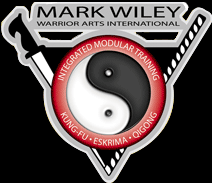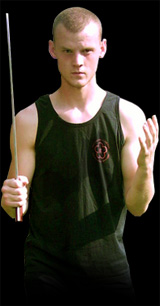|
 
Introduction
Integrated Eskrima was developed by Guro
Mark V. Wiley after studying Filipino martial
arts under dozens of teachers and masters in
the Philippines and United States. It is not
a new "style" of Filipino martial
art. What differentiates Integrated Eskrima
from other Filipino martial arts is not the
Content (root techniques) found in the system,
but the Context (methods) in which they are
learned, trained and taught. Integrated Eskrima
is a system of progressively learning, training
and teaching the 8 categories, 11 footwork methods,
14 striking methods, 12 angles of opportunity,
30 primary techniques, secondary techniques
and the various ranges, concepts and strategies
found in different numbers and in varying combinations
across the many established styles and systems
of Eskrima.
It is a system of fully Linking and Integrating
these methods in fully functional ways through
the Integrated Modular Training Methodology
(IMTM). To understand this better, let's
first discuss the differences between the terms
"system," "style" and "technique."
A "system" is an organized
set of basics and techniques taught and practiced
in an orderly fashion and progressing from points
A to Z. A system is not a bunch of loose techniques
or drills thrown together and practiced on a
whim, as that is merely impromptu, unorganized
and incorrect training.
A "style" is a personal way
of expressing or performing a set of defined
techniques. It is also often a synonym for a
category of techniques within Eskrima, such
as Abaniko. What a style is not, however, is
a system.
A "technique" is what is found
within systems and styles. Take, for example,
the Abaniko style. Abaniko is a generic name
for a fan-like method of attack and defense.
Within this method (or style of movement) you
have various techniques, such as fanning-style
blocks, strikes, disarms and locks,. When grouped
together, these techniques become the Abaniko
"style" or the Abaniko "method"
of employing the art. If you then group all
of the techniques into their respective styles,
and then combine the various styles into a cohesive
whole and proceed to teach them in an orderly
fashion, you have a system.
Integrated Eskrima's modular teaching progressing
is based on first Linking methods and techniques
and then Integrating them with the other methods
and techniques as applicable. Therefore, as
each new Module or block of information is learned,
its conceptual parameters are understood and
it is made fully functional with what has been
learned thus far. Therefore, every technique
is applied in its proper range and Linked with
other techniques in that range, and then is
Integrated with its proper footwork and follow-up
strikes, disarms, etc. In this way, while we
limit the number of techniques to range and
footwork and follow-up strikes, when combined
they form countless new techniques. For example,
within Medium Range we have the possibility
to make over 3,500 techniques based on proper
Linking and Integrating of relevant material
in that range alone!
In essence, Integrated Eskrima teaches no new
techniques. On the contrary, it confines (limits)
its techniques and methods to particular circumstance
and by doing so only trains its practitioners
to utilize them in their strongest moments,
and this is learned, trained and taught through
the Integrated Modular Training Methodology,
which is unique to the system.
The highest form of Integrated Eskrima is Kalis
Lusot Palisog -a sword method that is like water
flowing down stream: it moves around obstructions
and fills voids and crevices, as opposed to
being obstructed by them. The optimal goal of
the system is to discard blocks, always move
forward, and strike without being struck.
He may be contacted at markvwiley@yahoo.com
(Taken from
www.alanorr.com)
|